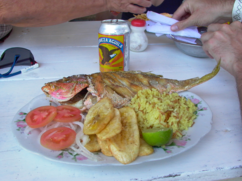South American cuisine
This article needs additional citations for verification. (August 2015) |


South American cuisine has many influences, due to the ethnic fusion of South America. The most characteristic are Native American, African, Spanish, Italian, Portuguese, and Indian-South Asian. However, there is a mix of European, North American, and indigenous cuisines.[1] The customs and food products greatly vary[2] according to the physically distinct regions.
Overview
The Amazon basin of South America provides a plethora of fresh fish and tropical fruits.[3] The Pacific Ocean provides a large amount of seafood, such as king crab (typically caught at the southern end of the continent), lobster (found in great quantities from the Juan Fernández Islands), and Antarctic krill, which was recently discovered. Tuna and tropical fish are caught all around the continent but are notably found in abundance near Easter Island.
The many plains on this continent make it rich for growing foods like
Shredded beef is common throughout South America and Latin America and is served with a variety of foods.[5]
By region
Andes

The food of the Andes is highly influenced by the indigenous peoples. The principal foods continue to be corn, potatoes[6] and other tubers. The meats most characteristic of this zone are the llama (Peru) and the guinea pig (Chile, Bolivia, Peru, Colombia and the Argentine northwest). In areas where there is fresh water, trout is consumed.
The wetter areas of Peru produce sugar cane, lemon, bananas, and oranges.
Pampas
The pampas have the most Italian and Spanish influences. In Argentina, they are the center of the three typical Argentinian dishes dulce de leche, asado (churrasco in Brazil), and milanesa.
Argentine pizza is different from Italian pizza, being closer to
Tropical
The tropical region of the continent is divided into two distinct areas, the coastal areas of the Atlantic and the Pacific and the Amazon area, each with its distinct cuisines. Much of the fruits that are considered to be exotic are common in the tropical forests and fields, such as guava, pineapple, papaya, mango, banana, and elderberry.
The climate and geography also favour a great variety of crops: potatoes, sweet potatoes, cassava, complemented with meat and fish; grains, principally rice, corn, and wheat and beans.
In the coastal area ceviche, tostones or patacón, arepa, chipa, sancocho, pabellón criollo, bandeja paisa, guatita, and sopa paraguaya are common dishes.
In Brazil, foods such as
The Amazon area is known for its utilization of native meats such as the capybara, turtles, peccary, and paca. Common dishes are juane, tacacho, tacacá. There are a wide variety of fruits native to the Amazon with which a great variety of drinks are prepared.
Diffusion
Australia
As early as the 1950s, Latin American cuisine have been transported to the Southeast coast, where
United States
Early South American restaurants in the United States included Caso do Brazil in
Gallery
See also
- Latin American cuisine
- Brazilian cuisine
- Argentine cuisine
- Chilean cuisine
- Peruvian cuisine
- Native American cuisine of South America
- Chifa
Footnotes
- ^ There appears to only be circumstantial evidence, for which there are a few references.[footnote 1][footnote 2]
- ^ “The Origins and Traditions of Carne Asada.” The Spruce, 1996, www.thespruce.com/carne-asada-mexican-steak-331500.
- ^ Martin, Sasha. “Barbecued Meat:Carne Asada.” Global Table Adventure, August 21, 2015, globaltableadventure.com/recipe/recipe-barbecued-meat-carne-asada-w-poll/.Which by the way, they source "Life from Scratch" A National Geographic Special Book
References
- ^ “An Introduction to South American Food.” The Spruce, www.thespruce.com/introduction-to-south-american-food-3029236.
- ISBN 978-1-4408-4090-6. Retrieved February 12, 2018.
- ^ "Amazonian Cuisine." Brazil-travel-guide.com. Accessed July 2011.
- ^ "The Definitive Vegetarian's Travel Guide to Eating in Meat-Loving Countries". HuffPost. September 28, 2017. Retrieved February 12, 2018.
- ISBN 978-1-4696-0881-5. Retrieved January 22, 2018.
- ISBN 978-0-7391-4761-0. Retrieved February 12, 2018.
- ISBN 978-0-8118-3184-0. Retrieved February 12, 2018.
- ISBN 978-1-84973-161-4. Retrieved February 12, 2018.
- ISBN 978-92-9060-205-7. Retrieved February 12, 2018.
- ISBN 978-1-77667-435-0. Retrieved February 26, 2018.
- ISBN 978-0-8225-4111-0. Retrieved February 12, 2018.
- ISBN 978-1-4236-4069-1. Retrieved February 12, 2018.
- ^ "The 12 Best Latin Restaurants in Sydney". Concrete Playground. May 31, 2012. Retrieved February 16, 2018.
Further reading
- Kijac, M.B. (2003). The South American Table: The Flavor and Soul of Authentic Home Cooking from Patagonia to Rio de Janeiro, with 450 Recipes. NYM Series. Harvard Common Press. ISBN 978-1-55832-249-3. Retrieved February 12, 2018. 478 pages.
- Food, SBS (December 3, 2008). "About South American food". SBS. Retrieved February 12, 2018.
External links
 Media related to Cuisine of South America at Wikimedia Commons
Media related to Cuisine of South America at Wikimedia Commons
|
Wikivoyage has a travel guide for South_American_Cuisine. Wikiquote has quotations related to South_American_Cuisine (Brazil). Wikimedia Commons has media related to Cuisine of South America. |


